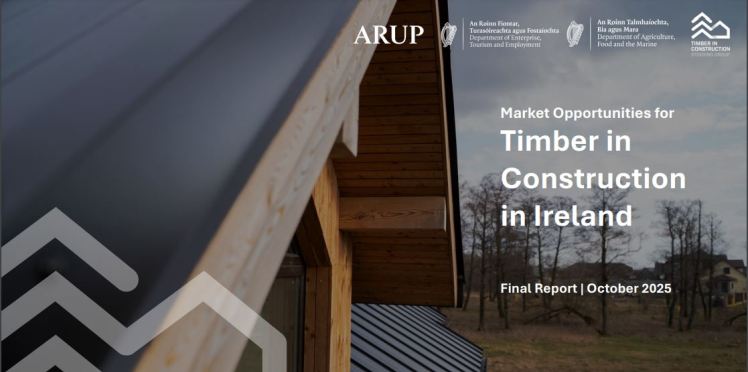Business
Ireland’s Timber Industry Set to Triple Market Value by 2030

Ireland’s timber construction sector is poised for significant growth, according to a comprehensive report from the Timber in Construction Steering Group. This landmark document provides a strategic framework for the timber industry to play a vital role in addressing Ireland’s housing shortages and achieving ambitious climate targets. The report, titled ‘Market Opportunities for Timber Construction in Ireland’, forecasts a potential tripling of timber use in construction by 2030, with market value projections reaching approximately €589 million.
The report highlights the existing strength of Ireland’s domestic timber manufacturing sector, noting that timber frame housing systems are widely utilized across the construction industry. It identifies a growing demand for engineered wood products, such as Cross-Laminated Timber (CLT) and Glulam, which are poised to revolutionize the market. Ireland’s favorable climate and fertile soils contribute to a robust supply of timber, making it a crucial resource for sustainable construction.
Analysis within the report reveals that by 2025, the volume of timber used in construction could reach nearly 670,000 cubic metres, valued at approximately €180 million. If accelerated adoption of timber products occurs, along with supportive policy changes and increased construction activity, this figure could surge to 1.85 million cubic metres. Such a shift would result in significant reductions in carbon emissions associated with traditional construction materials.
Mark McAuley, Director of Forest Industries Ireland, expressed optimism about the report’s implications. He emphasized the opportunity for farmers to capitalize on the future demand for timber, stating, “We have a massive opportunity to build more with wood in Ireland. All the planting of commercial forests in the 1980s and 1990s is now bearing fruit in terms of housing and the environment.” McAuley underscored the need for sustained growth in the timber industry, warning that current levels of afforestation must increase to meet demand anticipated in the 2040s and beyond.
The Timber in Construction Steering Group was initiated by the Department of Enterprise, Tourism and Employment and the Department of Agriculture, Food and the Marine. Its goal is to explore methods to enhance the use of timber in construction and address any regulatory hurdles faced by builders and designers. The group comprises representatives from key industry bodies, including Coillte, as well as senior officials from relevant government departments.
The report outlines several key projections regarding market growth in timber usage for construction:
– Under current conditions, timber usage is expected to increase from 668,000 m3 in 2025 to approximately 1,038,000 m3 by 2030, marking a 55% increase over five years.
– In an ideal scenario, driven by strategic policy interventions, timber adoption could rise to 1,785,000 m3, representing a 170% increase over the same period. This expansion could see timber accounting for 70% of new residential buildings by 2030.
The report positions timber not just as an alternative construction material but as a strategic solution for Ireland’s climate and housing challenges. The government’s Climate Action Plan aims to reduce embodied carbon in construction materials by at least 30% by 2030. The full realization of the best-case scenario outlined in the report could lead to the displacement of 2.8 million tonnes of carbon dioxide equivalent (CO2e) by 2030, contributing significantly to the nation’s climate goals.
To capture the projected growth and enhance the domestic timber market, the report offers several strategic recommendations:
– Establish a National Knowledge, Development, and Innovation (KDI) facility to facilitate technical guidance, training, and advocacy in the sector.
– Introduce temporary financial incentives to promote early adoption of Irish-grown timber and off-site timber systems, thereby boosting confidence and demand.
– Foster collaboration within the domestic value chain to enable the processing of Irish-grown timber into higher-value products, reducing reliance on imports and supporting rural economic development.
– Implement targeted awareness campaigns to improve understanding of timber’s performance, safety, and versatility among designers and developers.
– Conduct a feasibility study to explore the establishment of domestic manufacturing facilities for mass-engineered timber products through joint ventures, enhancing supply chain resilience.
The findings and recommendations from the ‘Market Opportunities for Timber Construction in Ireland’ report set the stage for a transformative period in the timber industry, aligning economic growth with environmental sustainability. As Ireland moves forward, the emphasis on timber construction not only addresses housing needs but also fosters a greener future.
-

 Top Stories3 months ago
Top Stories3 months agoTributes Surge for 9-Year-Old Leon Briody After Cancer Battle
-

 Entertainment4 months ago
Entertainment4 months agoAimee Osbourne Joins Family for Emotional Tribute to Ozzy
-

 Politics4 months ago
Politics4 months agoDanny Healy-Rae Considers Complaint After Altercation with Garda
-

 Top Stories4 months ago
Top Stories4 months agoIreland Enjoys Summer Heat as Hurricane Erin Approaches Atlantic
-

 World5 months ago
World5 months agoHawaii Commemorates 80 Years Since Hiroshima Bombing with Ceremony
-

 Top Stories3 months ago
Top Stories3 months agoNewcastle West Woman Patricia Foley Found Safe After Urgent Search
-

 Top Stories5 months ago
Top Stories5 months agoFianna Fáil TDs Urgently Consider Maire Geoghegan-Quinn for Presidency
-

 World5 months ago
World5 months agoCouple Convicted of Murdering Two-Year-Old Grandson in Wales
-

 World5 months ago
World5 months agoGaza Aid Distribution Tragedy: 20 Killed Amid Ongoing Violence
-

 World5 months ago
World5 months agoAristocrat Constance Marten and Partner Convicted of Infant Murder
-

 Top Stories4 months ago
Top Stories4 months agoClimbing Errigal: A Must-Do Summer Adventure in Donegal
-

 Top Stories4 months ago
Top Stories4 months agoHike Donegal’s Errigal Mountain NOW for Unforgettable Summer Views









